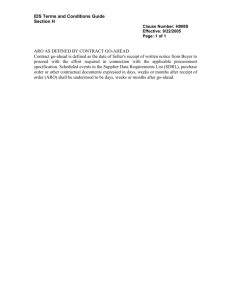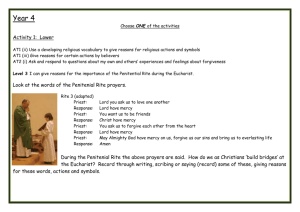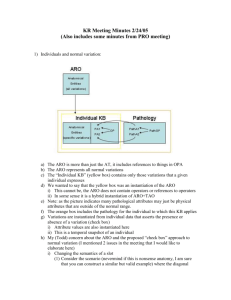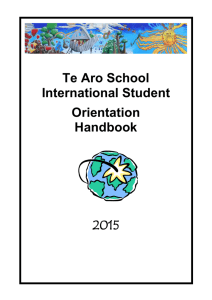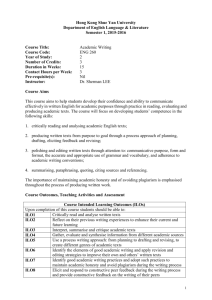Come and See - The Nottingham Roman Catholic Diocesan
advertisement
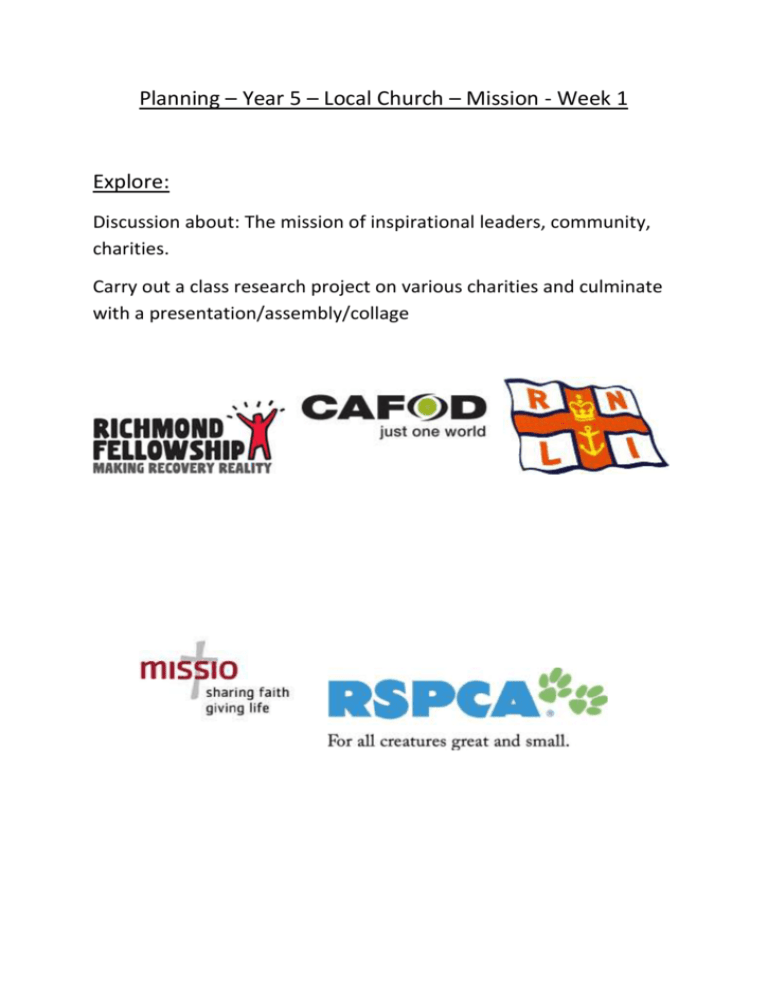
Planning – Year 5 – Local Church – Mission - Week 1 Explore: Discussion about: The mission of inspirational leaders, community, charities. Carry out a class research project on various charities and culminate with a presentation/assembly/collage Reveal: Learning Focus 1 L.O. To develop an understanding of Jesus’ message for the poor and being able to Good News for the poor(based on Isaiah 61:1-2,10-11) The spirit of God has been given to me. God has sent me to bring good news to the poor, to comfort the broken hearted, to set free those who are imprisoned to proclaim that the time has come when God will shower blessings on his people. My heart is filled with joy, with praise and thanks to God. I feel as if God has surrounded me in love, as if God has wrapped me up in a cloak of blessings. I feel like a bride dressed for her wedding, adorned in jewels. For just as surely as the earth sends up green shoots Just as surely as the garden makes seeds grow, so will God bring love and justice and praise to people. God’s Holy People or ‘People of God’ This name reminded the Jewish people that God chose them. The early Christians and the Church today use the same name. It is a reminder that the Church is the People God calls to be one family. Recognise some religious stories - AT1 (i) Recognise some of the messages within the story through symbol and pictures (as highlighted) AT1 (i) Re-tell the message of Isaiah AT1 (i). Re-tell the message of Isaiah through pictures and words for people today (Poster) (AT1 (i)) Make links between the story and beliefs – AT1 (i) Make links between the passage from Isaiah and Christian belief (L3) using the table below. Sentence/Phrase Good News to the poor Free those who are imprisoned Surrounded me in love Meaning Help those less fortunate. Christian Belief Giving to and caring for others. Show more understanding of the stories and their effect on people’s beliefs – AT1 (i) Describe and show a deeper understanding of some of the stories and how they affect what people belief and how they live (L4) Sentence/Phrase Meaning Good News to the poor Help those less fortunate. Christian Belief Ways that we, and others ‘live this out’ Giving to and Collecting for/ caring for fundraising others. Surrounded me in love Wrapped me up in a cloak of blessings God brings love and justice Reveal: Learning Focus 2 L.O. To learn more about Jesus’’ mission and to be able to Recognise how we and others can follow Jesus’ mission - AT1 (iii) Draw a pathway/road and draw or write things on it which shows how we follow Jesus’ mission. Describe ways in which we live it out - AT1 (iii) Using the Scripture and words above, describe ways in which we can ‘live out’ the mission of Jesus, just as the apostles did. AT1 (iii) Give reasons for our actions - AT1 (iii) Using the table below, explore each scenario and then think of a reaction, giving reasons for your choice, in light of learning about the mission of Jesus. AT1 (iii) Scenario Someone is all alone in the playground. Your friend is unpleasant to you Reaction Reason Go to them and invite Jesus asks us to love them to play. one another and care for each other Speak with them, sort Reconciliation, out the problem forgiveness. Show an understanding of how religious belief shapes lives – AT1 (iii) Using some of the Scripture passages mentioned and text below, imagine you are one of the apostles. Write about why you decided to follow Jesus and his mission, what beliefs shaped your decision and say why? All of life is a journey—a journey of love. Each of us has been called by the Lord to walk with Him, to share His life and love with His people. Open your heart to Jesus’ call in your own life These twelve disciples went forth throughout the known parts of the world and continued to show His greatness with all modesty and uprightness. From Jerusalem there went out twelve men into the world. These men were uneducated and of no ability in speaking. But by the power of God, they proclaimed to every race of men that they were sent by Christ to teach the word of God to everyone. Reveal: Learning Focus 3 & 4 amalgamated, using LF3 to introduce LF4. L.O. To understand more about the diocese and its mission, and to be able to Recognise some religious signs and symbols (AT1 (ii)) Invite the pupils to draw and label symbols linked with the diocese (Bishop’s crozier, mitre, crest) and location within the map- AT1 (ii) Describe some religious actions and symbols – AT1 (ii) Invite the pupils to design an information sheet on our Bishop and diocese. Within it, describe some of the actions and symbols which are associated with both the Bishop and his diocese – AT1 (ii) Give reasons for religious actions and symbols - AT1 (ii) Complete the above task but invite the pupils to include reasons, such as: a crozier is used to symbolise a shepherd’s crook, thereby leading his flock - AT1 (ii) Show an understanding of how religious belief shapes lives – AT1 (iii) Imagine you are a new bishop; write a letter to the parishes informing them of your mission in the diocese and how they can play their part in it.(AT1 (iii)). Please see: catholic-ew.org.uk for further information. Reveal: Learning Focus 5 Jesus’ prayer for his friends (based on John 17:11-12; 20-23) “Holy Father, I am coming to you. Keep my friends safe. They belong to you. Keep them close to you and to each other. Let them be as close as I am to you. I kept them close to you.” “Father, I pray for these my friends and for all those in the future whom they will bring to know me. Just as you and I are one, I pray that my friends will always be one with us and with one another. I pray that they will be so at one with one another, that everyone will know that you sent me, and that you have loved them as you have loved me.” L.O. To understand that Jesus wants us all to live together in unity and love with him and To recognise some religious words and phrases - AT1 (ii) Using one of the phrases from the above prayer (for example: Father, I pray for these my friends) invite the pupils to draw or paint a picture to represent this. To describe some religious phrases and actions – AT1 (ii) Choose 6/8 of the phrases from the prayer and describe how the apostles might act these out in their day to day life. To give reasons for the actions of the disciples – AT1 (iii) Prepare a debate about the difficulties encountered by the disciples in sharing Jesus’ mission: give reasons for certain action by them. To show understanding of how religious belief shapes lives – AT1 (iii) As above (within the debate), but higher order task, inviting pupils to show more understanding of how religious belief shaped the lives of the disciples (give further examples, explain reasons why!). Refer to http://www.bbc.co.uk/religion/0/18395824 for further information and detail on the 12 apostles. Reveal: Learning Focus 6 L.O. To understand that Christians are united through their love for Jesus and; To recognise some religious signs and symbols - AT1 (ii) Invite the pupils to choose the Christian signs and symbols from a selection of Christian and secular signs and symbols, place these in their books and label. To describe some religious signs and symbols – AT1 (ii) As above, but also describe what some of them mean. To give reasons for some of the signs and symbols – AT (ii) Pupils are invited not only to describe but also to give reasons why certain symbols are used For excellent definitions, refer to: http://christianity.about.com/od/symbolspictures/ig/Christian-Symbols-Glossary/ To show understanding of how religious belief shapes lives – AT1 (iii) Invite the pupils to choose 6 symbols and use these to explain, not only their meaning but how they would help a Christian in their belief. For example, the crucifix would represent Jesus’ sacrifice for us all, so we too should remember what Jesus did for us and live good lives as he would want us to. Planning – Year 5 – Eucharist – Memorial Sacrifice - Week 1 Explore: Discussion about how memories are kept alive. Memories – read Wilfred Gordon McDonald Partridge http://youtu.be/usnOEnTXabw Invite pupils to bring in mementoes and photographs linked to special memories Prepare memory bubbles or clouds to display and to also be used in a Liturgy/prayer reflection. Reveal: Learning Focus 1 - ASSESSED TASK! L.O. To develop an understanding of the Passover and to be able to: Recognise some signs and symbols linked to the Passover - AT1 (ii) Invite the pupils to draw and label some of the signs and symbols of Passover AT1 (ii) – L1 Describe some signs and symbols linked to the Passover - AT1 (ii) Do as above but add descriptions to these – AT1 (ii) – L2 To give reasons for some of the actions and symbols of Passover – AT1 (ii) – L3 Provide pupils with some key words, picture and symbols and invite them to complete the following table: Symbol/Action Lamb Description Reason for use Lamb is eaten on Passover, was also sacrificed commemorates the paschal (lamb) sacrifice made the night the ancient Hebrews fled Egypt Salt water sweet salad of apples, nuts, wine, and cinnamon Represents the mortar used by the Hebrew slaves to make bricks. Unleavened bread Charoset Bitter herbs http://www.dummies.com/how-to/content/the-symbolic-foods-at-a-passover-seder.html To show understanding of how religious belief shapes lives – AT1 (iii) Create a snapshot through the keyhole of what happened at Passover from the point of view of Moses or his wife and how it changed their lives and the effect it had on them. AT1 (iii) – L4 www.bbc.co.uk/learningzone/clips/the-passover-story/6599.html Reveal: Learning Focus 2 L.O. To develop an understanding of the Last Supper and to be able to: http://www.bbc.co.uk/learningzone/clips/the-last-supper/676.html Recognise the story of the Last Supper - AT1 (ii) Invite the pupils to draw and label the Last Supper scene. - AT1 (i)-L1 Retell the Last Supper story – AT1 (i) The pupils use their own words to tell the Last Supper story (newspaper, diary entry, role play, story board) – AT1 (i) – L2 To make links between the Last Supper and beliefs – AT1 (i) – L3 Share with pupils the following and unpick further, then write their own based on this and other research. AT1 (i) – L3 The Last Supper is the final meal that, according to Christian belief, Jesus shared with his Apostles in Jerusalem before his crucifixion. The Last Supper is commemorated by Christians especially on Maundy Thursday. Moreover, the Last Supper provides the scriptural basis for the Eucharist also known as "Holy Communion" or "The Lord's Supper". To describe and show understanding of religious sources, beliefs, ideas, feelings and experiences linked to the Last Supper – AT1 (i) Prepare an information sheet on the Last Supper for a non-Christian. Research the following: The Last Supper – Luke 22: 7-23 The Eucharist – memorial sacrifice El Greco or Leonardo da Vinci – depictions of the Last Supper Christian beliefs of sacrifice, body and blood of Jesus, those who are followers of Christ and partake in the Sacrament of the Eucharist become his friends, as those gathered at the table of the Last Supper. Bring all these together (linking them) – not always easy! Reveal: Learning Focus 3 L.O. To understand that the Eucharist keeps the memory of Jesus alive and to be able to: http://www.bbc.co.uk/learningzone/clips/the-last-supper/676.html Recognise some signs and symbols linked to the Eucharist - AT1 (ii) Invite the pupils to draw and label some of the signs and symbols linked to the Eucharist. - AT1 (ii)-L1 Describe some of the signs and symbols linked to the Eucharist – AT1 (ii) Invite the pupil to describe some of the signs and symbols linked to the Eucharist – AT1 (ii) – L2: In the liturgy and in all sacraments simple elements from life are brought forward and made sacred. Light, water, clothing, oil, hands, bread and wine are transformed from ordinary objects into the gift of God’s grace and presence with us, and we too are transformed into images of Christ. http://www.togetheratonealtar.catholic.edu.au/craft/dsp-content.cfm?loadref=36 A very good link relating to the Eucharist To give reasons for the signs and symbols used – AT1 (i) – L3 Invite the pupils to go further that the previous activity and give reasons e.g. Oil - For the Jewish people, our ancestors in faith, anointing with oil meant setting the person apart for a particular mission. Just as royalty and Priests are anointed for a particular mission, so are we as Christians given a particular mission to be Christ in the world today. AT1 (i) – L3 To describe and show understanding of religious sources, beliefs, ideas, feelings and experiences linked to the Last Supper – AT1 (i) Prepare a simple PowerPoint or storyboard on the Eucharist for children preparing to receive Jesus in Holy Communion to help explain to them what is happening and what they need to pay attention to. AT1 (i) – L4 (with sufficient detail!) Refer to the link below, very good! http://www.bbc.co.uk/religion/religions/christianity/ritesrituals/eucharist_1.shtml Reveal: Learning Focus 4 (amalgamate with LF6 - share both Contents) L.O. To understand that the Eucharist is a sacrifice (one we can ‘live out’) and to be able to (too much???) Recognise some signs and symbols linked to the Eucharist - AT1 (ii) Invite the pupils to draw their own picture which symbolises the Eucharist and sacrifice within (crucifix) - AT1 (ii)-L1 Describe some of the signs and symbols linked to the Eucharist – AT1 (ii) Invite the pupils to describe some of the signs and symbols linked to the Eucharist and sacrifice, produce a picture/information mini guide – AT1 (ii) – L2 To make links to show how feelings and beliefs affect their own and others behaviour – AT2 (i) – L3 Invite the pupils to write an advertisement for a L’Arche volunteer, explaining what sort of person is required, their values and personal skills. AT2 (i) – L3 To show understanding of how belief in the Eucharist shapes a Christian’s Life – AT1 (iii) – L4 Design a Charter to Life by based on the beliefs, experiences and messages within the Eucharist. AT1 (iii) – L4 (how do Christian ‘live it out’?). Link below gives good guidance on this! http://www.apostleshipofprayer.org/LivingtheEucharist.pdf Reveal: Learning Focus 5 L.O. To develop an understanding of the Eucharistic prayer II and to http://catholic-resources.org/ChurchDocs/RM3-EP1-4.htm Recognise some of the words and phrases from the prayer - AT1 (ii) Invite the pupils to draw their own pictures with some of the text from the prayer (AT1 (ii)-L1) for example - ‘he took bread and, giving thanks, broke it’ Describe some of the words and phrases from the prayer – AT1 (ii) Invite the pupils to describe some of the words and phrases from the Eucharistic Prayer II – AT1 (ii) – L2 For example: It is truly right and just, our duty and salvation, always and everywhere to give you thanks – this is said at the beginning of the Prayer and we remember to thank Jesus for everything. To give reasons for religious actions and phrases – AT1 (ii) – L3 As above, but pupils would need to give reasons for the actions and words .AT2 (i) – L3. For example: It is truly right and just, our duty and salvation, always and everywhere to give you thanks – this is said at the beginning of the Prayer and we remember to thank Jesus for everything because it is our duty to remember him and his sacrifice. To show understanding of how belief in the Eucharist shapes a Christian’s Life – AT1 (iii) – L4 Design a Charter to Life by based on the beliefs, experiences and messages within the Eucharist Prayer II. AT1 (iii) – L4 (how do Christian ‘live it out’?). Refer to following link: http://www.apostleshipofprayer.org/LivingtheEucharist.pdf Planning – Year 5 – Lent/Easter – Sacrifice - Week 1 Explore: Discussion about giving and refusing to give (appreciating the cost of giving). Story of a young carer: http://www.bbc.co.uk/schools/pshe_and_citizenship/personal_wellbeing/ Refer to the activities on page 142, these could also culminate in a debate with the motion: Never too difficult to give Reflection on Significance The life that I have Is all that I have And the life that I have Is yours. The love that I have Of the life that I have Is yours and yours and yours. A sleep I shall have A rest I shall have Yet death will be but a pause. For the peace of my years In the long green grass Will be yours and yours and yours. Reveal: Learning Focus 1 L.O. To realise that Lent is an opportunity to grow spiritually Lent is the Church’s seasons for discerning and doing good. In the Christian Year, Lent precedes and prepares for Easter. It is a penitential season and a time of spiritual growth. If people want to be followers of Jesus, they must be prepared to notice what others need and then see what they can do to help. During Lent this is traditionally put into practice through prayer, fasting and almsgiving. Christians make Lenten promises saying what they hope to do during Lent. Recognise some of the stories linked to Lent - AT1 (i) Invite the pupils to draw and label the story of Jesus spending 40 days and 40 nights in the desert – AT1 (i) – L1 Retell the story of Jesus in the desert – AT1 (i) Invite the pupils to role play, draw and /or write the story, describing the events and characters involved – AT1 (i) – L2 Use link to cartoon of story - http://youtu.be/O5bfxGNMY9c Give reasons for your actions – AT1 (iii). Invite pupils to make their own Lenten calendar. Leave a section on it to reflect each week on how your actions have shaped your life and that of others. AT1 (iii) – L3 Describe and show understanding of the beliefs, scripture and stories linked to Lent. AT1 (i) Design an information booklet on ‘Lent’. Include some of the related scripture and sources (as below), its meaning and how Christians act during this time and why, due to their beliefs. AT1 (i) – L4 The "we" of the Church is the community in which Jesus brings us together (cf. Jn 12:32), faith is necessarily ecclesial. And it is important to remember and to live this during Lent: each person must be aware that the penitential journey cannot be faced alone, but together with many brothers and sisters in the Church. The Pope concluded “Living Lent in a more intense and evident ecclesial communion, overcoming individualism and rivalry is a humble and precious sign for those who have distanced themselves from the faith or who are indifferent”. Emeritus Pope Benedict XVI Reveal: Learning Focus 2 L.O. To understand how and why Judas betrayed Jesus and to: Recognise some religious stories - AT1 (ii) Invite the pupils to draw and label some of the story from Mark 14: 10-11 - AT1 (i)-L1 Retell the Betrayal of Jesus by Judas – AT1 (i) The pupils use their own words to retell the story (newspaper, diary entry, role play, story board) – AT1 (i) – L2 To give reasons for actions by believers – AT1 (iii) – L3 Role-play moral decision making with a Conscience Alley to explore Judas’ betrayal of Jesus. Two rows of children give different advice to the pupil playing Judas. At the end ‘Judas’ has to decide which advice to take and explain why. AT1 (iii) L3 To show understanding of how religious belief shapes life AT1 (iii) L4 The level of questioning should be monitored in order to ensure a degree of giving reasons and explaining why certain actions were taken and decisions made. Reveal: Learning Focus 3 L.O. To learn about the significance of Holy Thursday and Good Friday (amalgamate LF3 & 4 - use both contents) – enough coverage? Recognise some religious stories - AT1 (i) Invite the pupils to draw or paint scenes from Holy Thursday and/or Good Friday AT1 (i)-L1 Retell some of the special stories – AT1 (i) The pupils use their own words to retell one or both of the stories (newspaper, diary entry, role play, story board) – AT1 (i) – L2 To give reasons for actions by believers – AT1 (iii) – L3 Write a report from Pilate to Caesar, the Roman Emperor, informing him of the trial of Jesus. Try to explain the actions of the High Priest and the Council. Give reasons for your decision. AT1 (iii) L3 To show understanding of how religious belief shapes life AT1 (i) L4 Use the activity on page 148 – exploring the painting of The Agony in the Garden by Bellini – exploring how the disciples felt, what they believed and what they learned. Reveal: Learning Focus 5 L.O. To understand and learn more about the Stations of the Cross and to Recognise some Lent/Easter stories - AT1 (i) Invite the pupils to design some of their own ‘Stations’ AT1 (i)-L1 Retell some of the Lent/Easter stories – AT1 (i) The pupils use their own words to describe what is happening in each picture/scene – AT1 (i) – L2 To make links between Lent/Easter stories and beliefs – AT1 (i) – L3 As above, however the description also makes links between the events and what Christians belief (as below). AT1 (iii) L3 Christians believe, according to Scripture, that Jesus came back to life, or was raised from the dead, three days after his death on the cross. As part of the Easter season, the death of Jesus Christ by crucifixion is commemorated on Good Friday, always the Friday just before Easter. Through his death, burial, and resurrection, Jesus paid the penalty for sin, thus purchasing for all who believe in him, eternal life in Christ Jesus. To show understanding of how religious belief shapes life AT1 (i) L4 Use the activity on page 150 – making the booklet for a younger child and including experiences, feeling and beliefs (need to explore this further- excellent resource below to support this activity) – AT1 (i)-L4 http://www.cptryon.org/prayer/child/stations/01.html Reveal – Learning Focus 6 L.O. To understand and learn more about Easter Sunday, the Resurrection and to: Recognise some Easter stories - AT1 (i) Invite the pupils to design their own picture board of Easter AT1 (i)-L1 Retell some of the Easter stories – AT1 (i) The pupils could create their own record/collage of events describing what happened – AT1 (i) – L2 To make links between Lent/Easter stories and beliefs – AT1 (iii) – L3 Write a letter to a local shop giving reasons why they should stock religious Easter cards relating your reasons to Christian beliefs, scripture, your ideas, feelings and experiences. You may also wish to design the card! AT1 (iii) – L3 To show understanding of how religious belief shapes life AT1 (iii) L4 Make a leaflet entitled ‘Why Easter is important to Christians’ describing how belief in the Easter story shapes the lives of Christians. Use Church’s Story 3 to refer to scripture, liturgy and beliefs. AT1 (iii) – L4 - Refer to the following link: http://www.bbc.co.uk/schools/religion/christianity/easter.shtml
